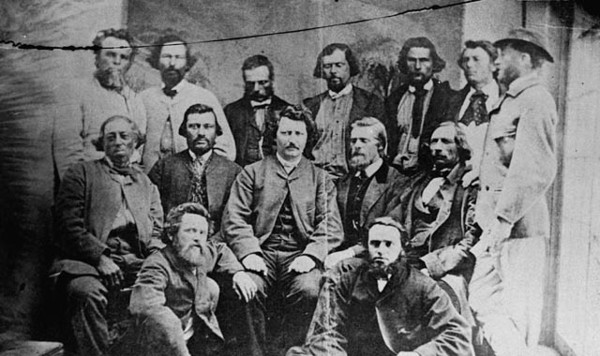- From the Red River Settlement to Manitoba (1812—70)
- Maps
- The Earl of Selkirk: The Colony’s Founder
- An Arduous Task, Marked by a Private War (1812—21)
- The Métis
- Indigenous Peoples
- Colonial Administration
- Maintaining Order and the Colony’s Defence
- Of Fur and Wheat: Subsistence and the Economy
- From Canoes to Railways: Transportation
- Life in Red River
- Missions and Religious Life
- Education, Health, and Social Assistance
- Arts and Culture
- The Press
- Intellectual and Scientific Life
- Winnipeg: The Emergence of an Urban Core
- Debating the Status of the Colony (1850—70)
- The Red River Rebellion and the Creation of Manitoba, 1869—70
- Suggested Readings on the Métis
The Red River Rebellion and the Creation of Manitoba, 1869–70

Source: Courtesy of Wikimedia Commons
The unrest that preceded the creation of Manitoba [see The Fenians] arose largely out of a desire on the part of many inhabitants of the Red River colony, including a large number of Métis led by Louis RIEL, that the transition to the status of Canadian province be made in a way that respected the rights of local peoples. After survey work began in the summer of 1869, fear over land rights was among the causes that led to rebellion later that year:
“As tensions mounted among the Métis it was clear that strong leadership was needed. Riel’s experiences during the past ten years had produced a life-style very different from that of the buffalo-hunting Métis, but it was these people he now aspired to lead. The older, more established leaders had had little success and had shown little initiative. Riel – ambitious, well-educated, bilingual, young and energetic, eloquent, deeply religious, and the bearer of a famous name – was more than willing to provide what the times required.
“Late in August 1869, from the steps of the St Boniface cathedral, Riel declared the survey a menace. On 11 October a group of Métis, including Riel, stopped the survey. A week later, the National Committee, with John Bruce as president and Riel as secretary, was formed in St Norbert with the support of the local priest, Joseph-Noël
In the fall of 1869 Prime Minister Sir John A. MACDONALD gave his interpretation of the rebellion’s origins:
“The main burden of blame Macdonald put upon officials of the [Hudson’s Bay Company]. The dissatisfaction of the Métis was well known to its local council. The transfer had been planned and known of for months. HBC officer John H. McTavish had been in Ottawa in April, had seen Macdonald and others, and had been told of the transfer of the northwest to Canada with the same rights for its inhabitants as had existed before. Yet company officials gave no explanation to the people of Red River about what was to happen. ‘All that those poor people know,’ Macdonald said to Cartier on 27 November, ‘is that Canada has bought the country… & that they are handed over like a flock of sheep to us; and they are told that they lose their lands…. Under these circumstances it is not to be wondered at that they should be dissatisfied, and should show their discontent.’”
The provisional government that took charge of Red River on 8 Dec. 1869 established a list of demands and prepared to negotiate with Canada, as related in the biography of Roman Catholic priest and missionary Noël-Joseph RITCHOT:
“On 11 Feb. 1870… Ritchot was once again in the public eye when he was named a delegate to the Canadian government in Ottawa, together with John
The negotiations, in which Sir George-Étienne CARTIER (one of the most important of the architects of Canada’s westward expansion and defenders of minority rights) played a key role, led to the provisional government’s ratification of the Manitoba Act on 24 June 1870 [see Sir George-Étienne Cartier]. The creation of the new province on 15 July, however, was followed by a period of instability and violence marked by Riel’s exile, as recounted in his biography:
“On 24 August Riel learned that the soldiers were planning to lynch him; he vacated Upper Fort Garry a few hours ahead of them. Accompanied by [William Bernard] O’Donoghue and a few others, Riel crossed the Red River to Taché’s palace in St Boniface. He told the bishop he had been deceived, but added: ‘No matter what happens now, the rights of the métis are assured by the Manitoba Bill; it is what I wanted – My mission is finished.’ Riel then proceeded to his home in nearby St Vital, where his mother lived; but growing more apprehensive about his safety he took refuge at St Joseph’s mission, about ten miles south of the border in Dakota Territory.”
The biographies that appear in the following lists provide additional information on this crucial chapter of the history of the Red River colony and of Canada.





